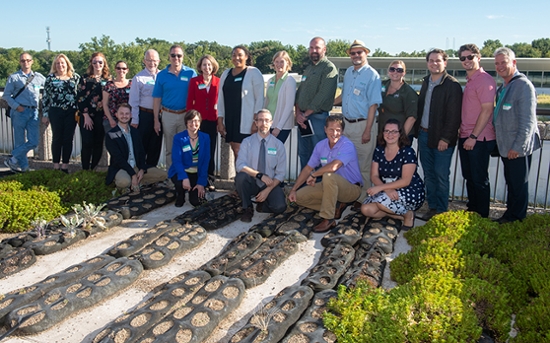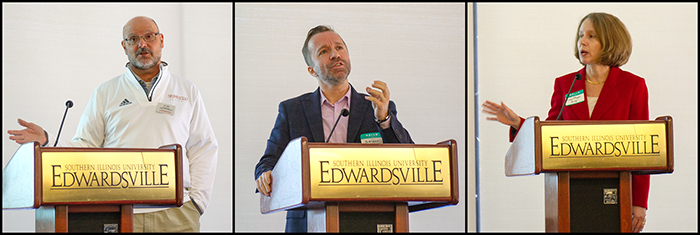SIUE G.R.E.E.N. Leaders Host Midwest Regional Green Infrastructure Symposium
 The Southern Illinois University Edwardsville Living Architecture Regional Center of Excellence (LARCE) hosted researchers, inventors and industry advancers on Monday, Sept. 23 for the Midwest Regional Green Infrastructure Symposium.
The Southern Illinois University Edwardsville Living Architecture Regional Center of Excellence (LARCE) hosted researchers, inventors and industry advancers on Monday, Sept. 23 for the Midwest Regional Green Infrastructure Symposium.
The one-day event featured a Living Architecture Seminar with presentations and panel discussions on topics of policy advocacy, maintenance challenges and best practices, cost-effectiveness, funding, incentives, and eligibilities, along with research advancements.
“This event offered the perfect opportunity to exchange ideas intellectually at the university level, and allowed us to collaborate with experts from Ohio, Missouri, Kansas and Illinois whose various markets have different strategies for living architecture,” said Bill Retzlaff, PhD, distinguished research professor of biological sciences and associate dean in the College of Arts and Sciences. “We’ve been fortunate to work with great collaborators with shared interest in living architecture, not only from the standpoint of implementing it, but also to provide opportunities for our students to learn about new technologies.”
In 2004, SIUE launched the Green Roof Environmental Evaluation Network (G.R.E.E.N.), a St. Louis metropolitan area research collaboration among the University and regional and local industries. In 2018, SIUE became one of four education institutions in the nation to receive the honorable LARCE designation from Green Roofs for Healthy Cities (GRHC), and its charitable arm, the Green Infrastructure Foundation (GIF).
SIUE’s LARCE will advance the work of G.R.E.E.N. under the director of Retzlaff, Susan Morgan, PhD, professor of civil engineering and associate dean in the SIUE Graduate School, and Serdar Celik, PhD, professor in the School of Engineering’s Department of Mechanical Engineering.
 SIUE teacher-scholars have produced a significant body of work evaluating living architecture systems in areas such as volume and quality of storm water runoff, plant performance, maintenance issues, biodiversity, thermal characteristics, weight loads, wind uplift and new green roof technologies. Approximately 150 student researchers, including 24 who have completed master’s theses, have worked on living architecture projects.
SIUE teacher-scholars have produced a significant body of work evaluating living architecture systems in areas such as volume and quality of storm water runoff, plant performance, maintenance issues, biodiversity, thermal characteristics, weight loads, wind uplift and new green roof technologies. Approximately 150 student researchers, including 24 who have completed master’s theses, have worked on living architecture projects.
“SIUE has been doing fantastic research on the performance of green roof systems, including interesting multidisciplinary studies that involve multiple engineering disciplines and plant sciences,” said Steven Peck, founder and president of GRHC North America and executive director of the GIF. “It was wonderful to see a wide variety of green infrastructure experts in attendance who came to network, and be involved in cross-academic fertilization that will hopefully lead to more funding for and recognition about this important work.”
The Symposium marked the Center’s first regional conference. Coordinators plan to host such an event annually or biennially.
“Our goal is to get more students involved, bring in practitioners from the private sector, and work with academics to advance the development of new systems, understand their performance and engage policy makers, so that we can create a flourishing job market for future graduates,” Peck noted.
“SIUE has been producing amazing work on green roofs and walls for a long time, and this symposium underscores their notoriety and excellence as a regional center,” added Reid Coffman, associate professor at Kent State University, executive director of the Greater Ohio LARCE and North American research chair for Green Roofs for Healthy Cities. “Research is critical, as it’s helped launch green roofs, walls and a lot of living architecture. The significance now lies in students becoming involved in greater numbers and great diversities of interest areas. Then, they can address research questions and take their findings out into the world to build, maintain and construct systems, and build policy around the systems, so that our cities are better places to live.”
Two of the seminar’s featured presenters have been longtime collaborators with SIUE, helping develop portions of the University’s six green roofs and two living architecture research areas.
Kelly Luckett, with Green Roof Blocks, spoke about the importance of maintaining green roofs, sharing examples of his projects over time and insights into the future of the green roof industry. For example, he noted his company has advanced its efforts by using pre-grown sedum tiles vs. sedum plugs. This change has led to faster growth establishment and decreased maintenance.
Luckett partnered with SIUE 10 years ago for the installment of the green roof on the Student Success Center. “That was a rewarding project, because students were involved,” Luckett recalled. “It was a merger of our commercial endeavor with SIUE’s educational mission, and that relationship has continued. We’re continuously asking new research questions and publishing our findings for the benefit of the industry.”
Mark Woolbright, of Greenwall Ventures, also spoke about “The “M” Word:” maintenance. As an inventor and innovator of vertical living walls, he shared his passion for the visual amenities that have such extensive positive impacts. Woolbright designed the living wall research plot located outside Bluff Hall that has contributed to multiple SIUE research studies.
Woolbright noted some of living walls’ positive impact involving earth retention, habitat, urban cooling, decreased storm water runoff, improved air quality, greenspace and carbon sequestration.
“Plants have always fascinated me, and I think they add a great deal to the built environment,” Woolbright said. “Humans are embracing plants in their environment like never before. Living walls come in many forms and service capacities. They’re about bringing plants in close proximity to humans for a number of benefits, in terms of worker productivity, health, mental wellness, stress reduction, better test scores and more. These are no longer being overlooked.”
For more information on G.R.E.E.N. and SIUE’s LARCE, visit siue.edu/green/about.
Green Roofs for Healthy Cities (GRHC) is a member supported industry association with a mission to develop the green roof and wall industry throughout North America. GRHC provides online and in-person training programs, manages the Green Roof Professional accreditation, publishes the Living Architecture Monitor, organizes events to support market development and advocates for supportive policy.
The Green Infrastructure Foundation is a charity that partners with communities to shape healthy, resilient, and sustainable places using living green infrastructure.
Photos: The Living Architecture Seminar concluded with a networking reception at SIUE’s Fixin’s Restaurant, which overlooks the University’s garden roof.
Among those presenting at the Living Architecture Seminar were SIUE’s (L-R) Bill Retzlaff, Serdar Celik and Susan Morgan.









